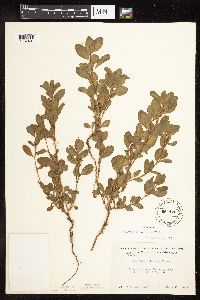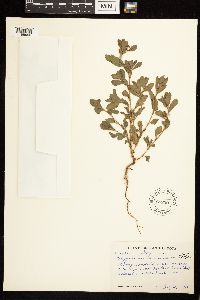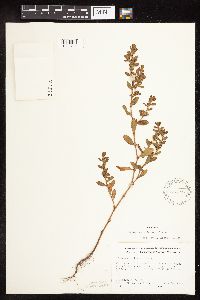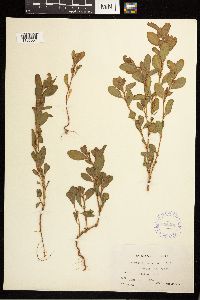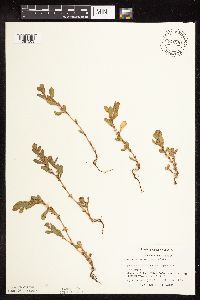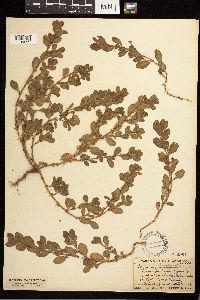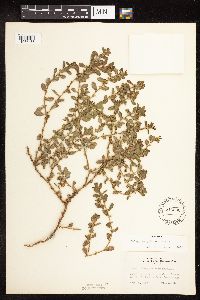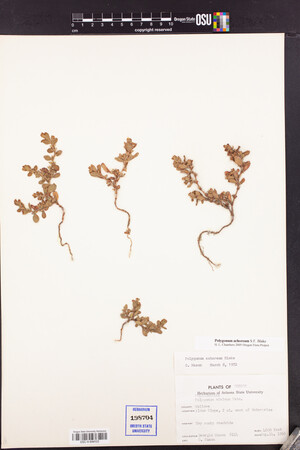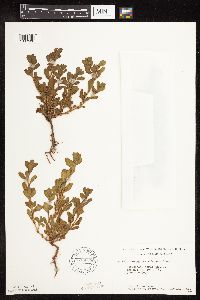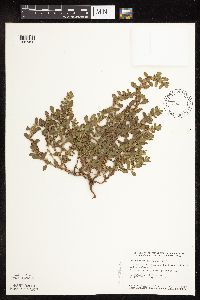Polygonum achoreum
|
|
|
|
Family: Polygonaceae
Leathery Knotweed, more...striate knotweed
|
Plants light green (often covered with whitish powdery mildew), homophyllous or, sometimes, heterophyllous. Stems erect when young, decumbent or prostrate later, moderately branched especially from base, not wiry, 50-70 cm. Leaves: ocreae 5-12 mm, proximal part cylindric, distal part soon disintegrating into brown fibers; petiole 0.3-1.5 mm; blade light yellowish green, elliptic to obovate, 8-35 × 3-15 mm, margins flat, apex rounded; stem leaves 1-2.1(-3) times longer than branch leaves; distal leaves overtopping flowers. Inflorescences axillary, cymes in axils of most leaves and toward tips of stems and branchs, 1-3(-5)-flowered. Pedicels enclosed in ocreae, 1.3-1.8(-2) mm. Flowers closed; perianth 2.6-4 mm; tube 40-55% of perianth length; tepals incurved, yellow-green with yellow to green, rarely pinkish, margins, sepaloid, ± keeled, narrowly oblong, cucullate; midveins unbranched, moderately to heavily thickened, tepals appearing keeled; stamens 5-8. Achenes enclosed in perianth, yellow-green to tan, ovate, 3-gonous, 2.4-3.5 mm, faces unequal, apex not beaked, edges concave or nearly straight, dull, uniformly tubercled; late-season achenes common, 3-5 mm. 2n = 40, 60. Flowering Jul-Sep. Disturbed areas, roadsides, sidewalks, edges of cultivated fields; 10-800 m; Alta., B.C., Man., N.B., N.W.T., N.S., Ont., Que., Sask., Yukon; Alaska, Colo., Conn., Idaho, Ill., Ind., Iowa, Kans., Maine, Mich., Minn., Mo., Mont., Nebr., Nev., N.Y., N.Dak., Ohio, Oreg., S.Dak., Utah, Vt., Wash., W.Va., Wis., Wyo. Polygonum achoreum frequently is confused with P. erectum. It can be distinguished by its usually homophyllous leaves, its perianth, which is enlarged at the base and constricted above the fruit, its longer perianth tube, and its yellow-green to tan, tubercled achenes.
Annual to 5(-7) dm, homophyllous, erect at first, but often becoming prostrate with upturned branches; lvs bluish-green, oval to elliptic with rounded tip, mostly 10-35 נ3-15 mm; ocreae 4-10 mm, becoming brown and lacerate; perianth yellow-green, 2.5-3.7 mm, somewhat bottle-shaped and constricted above the achene, cleft only ca 1/3 its length, the 3 outer lobes narrow, curved, strongly cucullate; achenes 2.4-3.3 mm, yellow-green to tan, uniformly papillose; late- season achenes exsert, to 5 mm, olivaceous, smooth; 2n=40, 60. A weed in waste places, widespread in our region, w. to the Rocky Mts. Gleason, Henry A. & Cronquist, Arthur J. 1991. Manual of vascular plants of northeastern United States and adjacent Canada. lxxv + 910 pp. ©The New York Botanical Garden. All rights reserved. Used by permission. From Flora of Indiana (1940) by Charles C. Deam Indiana Coefficient of Conservatism: C = 0 Wetland Indicator Status: FAC |













































